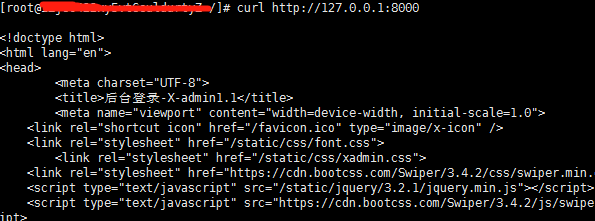nginx + uwsgi 釋出django專案!(linux為centos7)
1.在linux上安裝python3,參考連結:https://www.cnblogs.com/kimyeee/p/7250560.html
安裝python3時候,建議不要更改預設的python ,,預設python指向python2,,linux有一些東西需要用到,,比如yum,,如果將python預設指向python3,,這些東西將不可用
2.安裝django,直接pip3 install django
3.安裝uwsgi:
安裝依賴:yum install zlib-devel bzip2-devel pcre-devel openssl-devel ncurses-devel sqlite-devel readline-devel tk-devel
安裝uwsgi:pip3 install uwsgi
檢視版本:uwsgi --version
測試:
準備測試檔案test.py,程式碼如下:
def application(env, start_response): start_response('200 OK', [('Content-Type','text/html')]) #return ["Hello World"] # python2 return [b"Hello World"] # python3
將檔案上傳linux ,使用lrzsz , 安裝lrzsz:yum install lrzsz
然後,執行 uWSGI:
uwsgi --http :8000 --wsgi-file test.py
開啟下面url,瀏覽器上應該顯示hello world
curl http://127.0.0.1:8000
效果展示:

4.連結uwsgi和django
將自己的django專案上傳伺服器,安裝專案中需要的模組
進入上傳的專案資料夾 與manage.py同目錄執行:
uwsgi --http :8000 --wsgi-file appname/wsgi.py #appname為你自己的目錄
在其他視窗開啟連線:http://127.0.0.1:8000
效果:

出來顯示的是首頁前段程式碼
這證明上邊的步驟沒問題
5.安裝配置nginx
(1)安裝
wget http://nginx.org/download/nginx-1.9.5.tar.gz
tar xf nginx-1.9.5.tar.gz
cd nginx-1.9.5
./configure --prefix=/usr/local/nginx --with-http_stub_status_module --with-http_gzip_static_module
make && make install
或者參考
http://cantgis.blog.51cto.com/5788192/1540004
(2)啟動:進入安裝的nginx目錄下
/usr/local/nginx/sbin/
啟動:
./nginx start
重啟:
./nginx -s reload
啟動好之後在我們電腦的瀏覽器輸入伺服器ip會顯示nginx頁面,如圖:

6.使用uwsgi的配置檔案執行django
#user root nobody; worker_processes 1; #error_log logs/error.log; #error_log logs/error.log notice; #error_log logs/error.log info; #pid logs/nginx.pid; events { worker_connections 1024; } http { include mime.types; include uwsgi_params;#沒有這個會報錯在uwsgi錯誤日誌裡:self.method = environ['REQUEST_METHOD'].upper();KeyError: 'REQUEST_METHOD'
default_type application/octet-stream; #log_format main '$remote_addr - $remote_user [$time_local] "$request" ' # '$status $body_bytes_sent "$http_referer" ' # '"$http_user_agent" "$http_x_forwarded_for"'; #access_log logs/access.log main; sendfile on; #tcp_nopush on; #keepalive_timeout 0; keepalive_timeout 65; #gzip on; server { listen 80; #server_name localhost; server_name 對外訪問ip; access_log /www/www/access.log; error_log /www/www/error.log; #charset koi8-r; #access_log logs/host.access.log main; location / { root html; index index.html index.htm; uwsgi_pass 127.0.0.1:8088;#和uwsgi埠對應 uwsgi_read_timeout 300; } #error_page 404 /404.html; # redirect server error pages to the static page /50x.html # #error_page 500 502 503 504 /50x.html; #location = /50x.html { # root html; #} location /static/ { alias /www/www/webJB/webjb/static/; index index.html index.htm; } }
新建一個my_uwsgi.ini ,內容如下:
[uwsgi] #http = :9000 #the local unix socket file than commnuincate to Nginx socket = 127.0.0.1:8088 # the base directory (full path) chdir = /www/www/webJB/webjb # Django's wsgi file wsgi-file = webjb/wsgi.py # maximum number of worker processes processes = 4 #thread numbers startched in each worker process threads = 2 vacuum = true ##monitor uwsgi status #stats =127.0.0.1:9191 ## clear environment on exit #vacuum = true #stopsignal = QUIT daemonize = /www/www/webJB/uwsgi.log #stats=/root/uwsgi/uwsgi.status #pidfile=/root/uwsgi/uwsgi.pid
將檔案放入manage.py同目錄下
執行:uwsgi --ini my_uwsgi.ini
如圖:

即可,
重啟nginx,訪問域名,可以了
